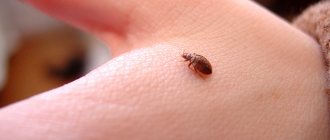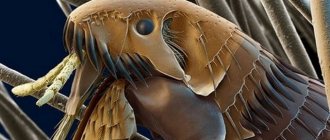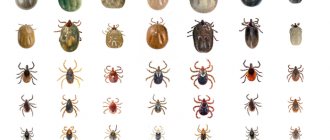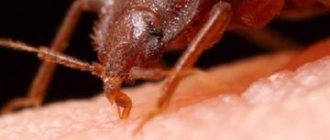What does a blood-sucking parasite look like: description and photo
The body length of a human flea reaches 3 mm. Insects can be recognized by the following characteristics:
- flattened body shape;
- black-brown or brown color of the body;
- numerous hairs and hooks covering the limbs and body of the parasite;
- lack of wings.
To distinguish a human flea from its relatives, you will need a magnifying glass or microscope.
Externally, the insect may look like a brown seed. The photos and pictures show close-ups of what fleas (moose, rat, etc.) and their larvae look like, as well as what bites look like on human skin on various parts of the body.
Features of fleas
About 90% of parasites live in the basements of residential buildings. From there they move into apartments.
Most often, residents of the lower floors are exposed to flea infestations. In addition, insects can disturb those who live close to the roof. This is explained by the fact that fleas love to live in nests that birds make in attics.
Pests can enter a person’s home in several ways:
- caught on the clothes and shoes of passers-by;
- independently moving from neighboring apartments, as well as from attics and basements;
- with pets.
The maximum life cycle of a flea is 500 days, but individuals usually live only a few months. During this time, the female manages to lay about 500 eggs.
What is the best way to protect your pets from fleas?
Most fleas prefer to feed on pets than people. Fleas can cause severe itching on your dog or cat. It is also difficult to stop pets from being scratched or bitten by fleas, which can easily cause infections.
Try oral or topical medications
Ask your veterinarian which flea medications are best for your pet. These may be oral medications you get with a prescription or topical medications you buy in stores or online.
Flea collars may also work
Flea collars can also be effective.
Always check your pet's weight before purchasing any flea treatment. Many are designed for animals based on their size and weight. Using the wrong dosage can be dangerous for your pet.
Monitor for adverse reactions
Any flea treatment that contains chemicals, such as pyrethrum, can negatively affect your pet. Monitor your pet for adverse reactions when using flea products. These may include:
- vomiting or diarrhea;
- muscle tremors or weakness;
- labored breathing;
- falls;
- heavy salivation;
- severe itching;
- lethargy;
- abnormal behavior of any kind.
If your pet has a reaction to flea medication, stop using it and contact your veterinarian immediately.
Bathe your pet regularly if he spends a lot of time outdoors.
Remember to regularly bathe your pets in warm, soapy water, especially if they spend time outside in the grass, forest or beach.
Daily flea combing can be very effective
For cats and dogs, daily flea comb care can be very effective. Keep in mind that fleas are fast jumpers and have tough shells, making them difficult to squash.
When brushing your pet, dip the comb in a warm, soapy solution between strokes. This will drown the fleas you removed and prevent them from re-entering your pet's fur.
It's always best to groom your pet outside to prevent fleas from finding a new home on your carpet or floor.
If you find an error, please select a piece of text and press Ctrl+Enter.
Specifics of behavior
Fleas jump well, easily covering distances of up to 50 cm. Parasites most often move along areas of the skin covered with hair, but they cannot stay in one place for a long time.
Having drunk the blood of their victim, the pests hide in secluded corners of the house and lay eggs. In an apartment, fleas most often hide in the following places:
- in the cracks of baseboards, trim, window sills;
- in a rug located near the front door;
- in folds of furniture, soft toys;
- in closets with clothes and bed linen;
- in animal bedding, bird cages;
- in the bathroom, sinks.
Organic dust particles or excrement of adults are sufficient to feed the hatched larvae.
Signs of dangerous pests and the consequences of their bites
The presence of fleas in the house can be recognized by characteristic bites , which are located not only on the head, but also on other parts of the body. Fleas bite into the skin with force, so it is almost impossible not to notice the attack of the parasite.
At the site of the bite, a red spot or blister up to 5 mm in diameter appears with a red dot in the center. In some people, insect saliva can trigger hives or allergic rashes. Bites heal in 3–5 days.
Flea bites are very itchy. By touching wounds with dirty hands, a person can infect them. When pathogenic microorganisms come into contact with the damaged epidermis, suppuration and intoxication occur.
Why are flea attacks dangerous?
A single flea bite does not pose a serious threat to human health. But with systematic attacks by “bloodsuckers”, the following complications can develop:
- Unbearable itching and burning of the affected areas of the skin. This in itself is not a complication. The danger of infection lies only in those who furiously scratch the bite sites.
- Mental or neurological disorders (a person is constantly attacked by imaginary insects).
- Acute allergic reactions, dangerous in their rapidity, which can be complicated by Quincke's edema and anaphylactic shock.
- Infection of the body with helminths.
- Damage to the body by toxic substances from flea saliva.
In addition, fleas living on sick or dead animals can carry parasitic worms and fungal infections. Zoonotic infections (tularemia, listeriosis, brucellosis) “borrowed” by insects from animals pose a significant danger. Such diseases are difficult to diagnose and almost impossible to cure.
What types can cause harm?
- All types of fleas that attack humans are carriers of dangerous diseases. Most often, people suffer from dog and cat parasites.
- Rat fleas in the Middle Ages infected their victims with plague. Now this disease is not common, but it has been replaced by other dangerous pathologies.
- Rabbit parasites attack humans only in the wild. Therefore, when going into the forest, you should make sure that your clothes completely cover your legs, which bloodsuckers can bite into.
- People are also bitten by pests whose hosts are herbivores, mainly moose.
- Black ground fleas, also called basement or floor fleas, usually do not rise higher than 50 cm from ground level. For this reason, insects settle on the lower and basement floors.
Due to the fact that it is almost impossible to determine what type of parasite it is without special equipment, fleas that bite humans are popularly called bed fleas or linen fleas.
Bloodsuckers multiply quickly, so if they are detected, measures should be taken immediately.
How to recognize flea bites?
Not in all cases it is possible to determine which insect attacked a person. To take appropriate action, it is important to learn to recognize the symptoms of bloodsucker bites. Fleas mainly bite humans in areas with the thinnest skin: the popliteal and armpit cavities, waist and legs. However, there are exceptions.
Bed flea bites are accompanied by severe itching, slight swelling and redness. Because the wound is too small, it is not possible to determine the location of the skin bite. If the insect attacked a person alone, a characteristic chain of bites will appear, the distance between which is no more than 2 cm, but if there were many of them, the wounds can be localized throughout the body.
What does a bite entail: main symptoms
Experts have found that fleas are carriers of more than 200 dangerous bacteria and viruses. Victims of parasites may develop the following diseases:
- salmonellosis;
- brucellosis;
- Siberian plague;
- encephalitis;
- tularemia.
But most often people become infected from bloodsuckers with pulicosis, which has the following symptoms:
- enlarged lymph nodes;
- migraine;
- sleep disturbance;
- causeless irritability;
- high body temperature;
- wounds on the skin and mucous membranes that do not heal for a long time;
- rash in the area of the bite.
What infections can fleas carry?
The insects themselves cause severe skin lesions - sarcopsillosis and pulicosis. However, by feeding on the blood of an infected victim, fleas become carriers of more than 25 dangerous infections (and the viability of pathogenic microbes in the parasite’s body remains for a year).
The 10 most dangerous include:
- tularemia;
- encephalitis;
- anthrax;
- plague;
- typhus;
- salmonellosis;
- listeriosis;
- hepatitis;
- brucellosis.
Means of struggle
Treating the human body will not lead to the disappearance of fleas because these insects live indoors. The following means are used to combat parasites:
- Aerosols that need to be sprayed in a room infested with fleas: Raptor, Dichlorvos, Get, Raid.
- Powders that allow you to destroy insect larvae: Phenaxin, Clean House, Fas-double. It is necessary to sprinkle the powder throughout the house, paying special attention to the cracks, and after 5-6 hours, remove the product with a vacuum cleaner. In places where children and pets cannot reach, you can leave the product for 2 months.
- Concentrates that are diluted with water and used to treat the room, as well as furniture and other interior items: Nilar, Chlorophos Executioner, Selamectin.
- Steam generator for processing mattresses, pillows and textiles.
- Vacuum cleaner with disposable bags , with which you can significantly reduce the flea population. It is important to immediately throw the bag away from the house.
When working with insecticides, it is necessary to use personal protective equipment:
- special suit;
- respirator;
- gloves.
Before processing, the living space must be prepared:
- Seal food products.
- Carry out wet cleaning.
- Take pets out. If you cannot clean the aquarium, you can close it tightly and turn off the filtration system.
- Textiles and clothing should be washed and allowed to dry in the sun.
- After treatment, the rooms need to be ventilated. You should not do wet cleaning for 3-5 days so that the product has time to take effect.
It is necessary to treat not only living rooms, but also the attic and basement. This is where the most parasites can be found. It is imperative to get rid of fleas from your pets.
All flea control activities must be carried out on the same day.
Don't expect fleas to disappear from your apartment on their own. Parasites can go for long periods without food, and they also bite animals, including mice. If independent actions are ineffective, you need to call exterminators. Specialists spray highly effective preparations using special equipment that ensures that steam, poisonous to insects, penetrates into every crevice.
To reduce the risk of parasites re-entering your home, you must take the following measures:
- Ensure cleanliness is maintained. Insects most often appear in cluttered apartments with inadequate sanitary conditions.
- At least once a month it is necessary to carry out general cleaning. During this process, it is recommended to wipe all surfaces with a solution of soda and laundry soap that repels insects.
- It is recommended that pets wear flea collars impregnated with insecticide.
- When animals return home from the street, it is worth washing their paws.
- When going outdoors, you need to wear clothes that cover your arms, legs, and hair as much as possible. The sleeves and legs should have thick cuffs to prevent bloodsuckers from reaching the skin.
- If contact with stray animals is necessary, clothing and exposed areas of the body should be treated with sprays such as Biban, Gardex, Off-Extreme, Gall-Rat.
Actions for allergies to flea bites and the development of irritations
If the development of an allergic reaction is not stopped in a timely manner, parasite bites can provoke severe and life-threatening conditions. The following symptoms should be a cause for concern:
- difficulty breathing, sometimes barking cough;
- rapid swelling of the ears, lips, tongue;
- pallor;
- tachycardia.
Having noticed the listed symptoms, the victim needs to be given an antihistamine: “Suprastin”, “Diazolin”, “Eden” and call an ambulance. Without timely assistance, these symptoms develop into angioedema and anaphylactic shock. Life-threatening complications require highly qualified medical care and specialist supervision, even after the patient’s condition has been stabilized.
What to do and how to treat?
If you notice a flea bite on your body, you should immediately wash the affected area with soap and lubricate it with an antiseptic. After this, the blisters can be treated with the following means:
- Hydrocortisone ointment;
- Flucinar;
- sulfur ointment;
- Fenistil-gel in case of severe itching;
- balm "Rescuer".
If the victim is predisposed to allergic reactions, it is recommended to take an antihistamine, for example Claritin, Cetrin, Fexofenadine, etc.
The danger of human flea bites should not be underestimated. Insects are carriers of dangerous diseases, so the fight against them must begin immediately. You can find a wide range of insecticides on sale, in addition, you can resort to the services of specialists.
Flea bites in children
Children have thinner skin than adults, and the immune system is not fully developed, so flea bites cause a more severe reaction in the body. Even one insect bite can cause hives. This symptom makes it very difficult to identify the “aggressor,” especially in children of the first year of life.
More often than adults, children develop an allergic reaction, manifested by a clear clinical picture:
- a sharp increase in temperature to abnormal levels;
- diarrhea;
- nausea;
- difficulty breathing;
- chills;
- anxiety;
- subcutaneous hemorrhages (occur much less frequently than in adults).
Moreover, children scratch itchy bites until they bleed, which is why they are at risk for secondary skin infections. Due to constant discomfort, some babies develop nervous disorders.











